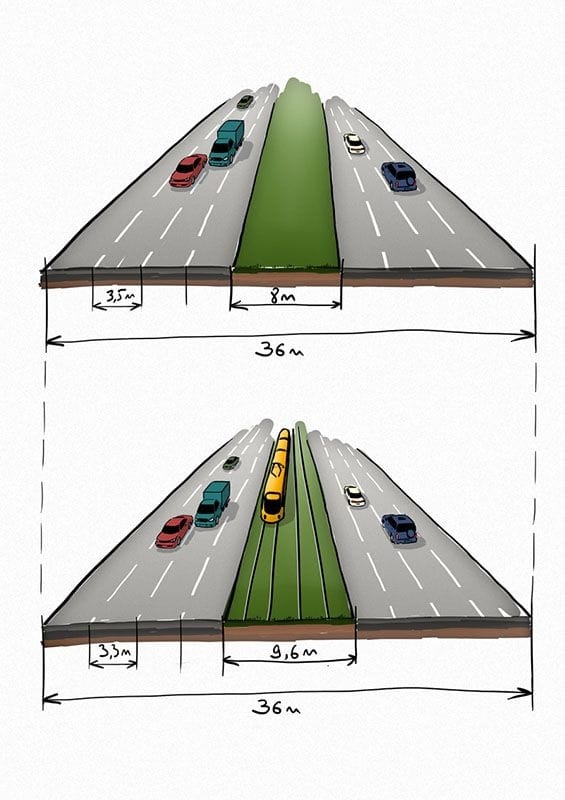
Lane width according to GOST
All issues related to the improvement of roads in the Russian Federation are described in a document called GOST R 52399-2005. In particular, there are the following points:
- what speed can be developed on sections of the road with one or another slope;
- parameters of the road elements - the width of the carriageway, shoulders, the width of the dividing lane for multi-lane highways.
On our automotive portal Vodi.su, in this article we will consider exactly the second point - what lane width is provided for by Russian standards. Also, quite relevant problems: is it possible to somehow defend one's innocence if an accident happened on a narrow highway that does not meet the standard? Is there any way to avoid liability or obtain compensation if your car was damaged due to the poor condition of the road surface in the region where you live?

Definitions of the concept - “Lane”
The carriageway, as you know, in most cases is designed for the movement of cars in both directions. A two-way road consists of at least two lanes. Today in Russia there is an active road construction and high-speed highways with four lanes for traffic in one direction are not uncommon.
Thus, according to the rules of the road, a traffic lane is a part of the carriageway along which vehicles move in one direction. It is separated from other lanes by road markings.
It is also worth replacing that so-called roads for reverse traffic have appeared in many cities, which we have already written about on Vodi.su. On reversible roads, traffic in one lane is possible in both directions at different times.
GOST
According to the above document in Russia, the following lane width for roads and highways of various categories is determined:
- expressways of categories 1A, 1B, 1C for 4 lanes - 3,75 meters;
- roads of the second category (not high-speed) for 4 lanes - 3,75 m, for two lanes - 3,5 meters;
- third and fourth categories for 2 lanes - 3,5 meters;
- fifth category (single-lane) - 4,5 meters.
This document also provides data for the width of other road elements. So, on highways these are the following values:
- shoulder width - 3,75 meters;
- the width of the edge strip at the curb is 0,75 m;
- the width of the reinforced part of the curb is 2,5 meters;
- dividing line on 4-lane highways (without fencing) - at least six meters;
- dividing line with a fence - 2 meters.
In addition, the dividing line, with or without a fence, must be separated from the carriageway by a safety margin that cannot be narrower than 1 metre.
Separately, it is worth dwelling on such a moment as the width of the lane on urban roads. Very often it does not match the required values. This is explained by the fact that the central districts of many cities in Russia were built back in those distant times, when there were no cars at all. That's why the streets are narrow. If we are talking about newly built city highways, then their width must necessarily comply with the requirements of GOST.

However, traffic on roads already 2,75 meters is prohibited. This applies to both cities and intercity trips. This rule does not apply to utility vehicles or delivery vehicles. Such narrow passages can also be found in residential areas, but they are not intended for through traffic.
Categories of highways
In the Russian Federation, the categories and classification of highways are considered in GOST 52398-2005. According to it, autobahns belong to the first and second category expressways, with at least 4 lanes for traffic in one direction. They also necessarily have multi-level interchanges and multi-level intersections with railways, roads, pedestrian or bicycle paths. Pedestrian crossings only through bridges or underpasses.
On such a road, you are unlikely to have to wait at the railway crossing until the train passes. It is to this class that the Moscow-St. Petersburg highway, which is being built for the 2018 World Cup, will be assigned. We already wrote about it on Vodi.su.
Roads of the second and all subsequent categories are not equipped with dividing fences. The section is marked with markup. Also intersections with railways or pedestrian crossings on the same level. That is, these are simple routes of regional significance, it is forbidden to accelerate faster than 70-90 km / h on them.

Violation of traffic rules on a narrow road
Many drivers may complain that they broke the rules or hit a pedestrian on a road that is too narrow. According to the SDA, if the violation was committed on a road wider than 2,75 meters, then you are unlikely to be able to prove anything.
It is a completely different matter when, due to the unsatisfactory work of road and public utilities, the width of the carriageway decreases. For example, in winter you can often see huge piles of snow and snowdrifts on the side of the road, due to which the width decreases. Because of this, during the maneuver, the driver can drive into the oncoming lane, and for such a violation a fine of 5 thousand or deprivation of rights for six months is possible (Code of Administrative Offenses 12.15 part 4).
In this case, you can, for example, measure the width of the road, and if it turns out to be less than 2,75 meters, then you can get off under article 12.15, part 3 - driving into the oncoming lane when avoiding obstacles. The fine will be 1-1,5 thousand rubles. Well, if you wish, you can enlist the help of experienced auto lawyers who will not only prove your innocence, but also force public utilities or road services to compensate for the damage.
But, despite the weather conditions and the condition of the road surface, remember that according to the traffic rules, the driver must take into account not only the traffic situation, but also the condition of the roadway.
Loading…

